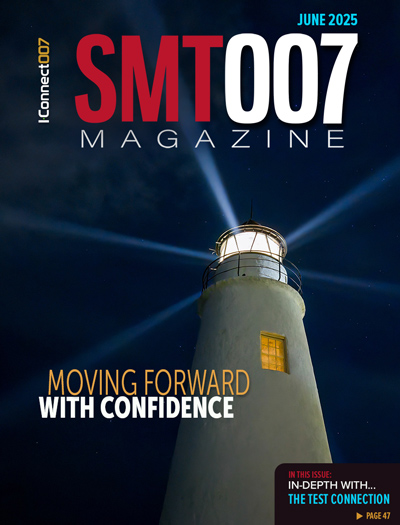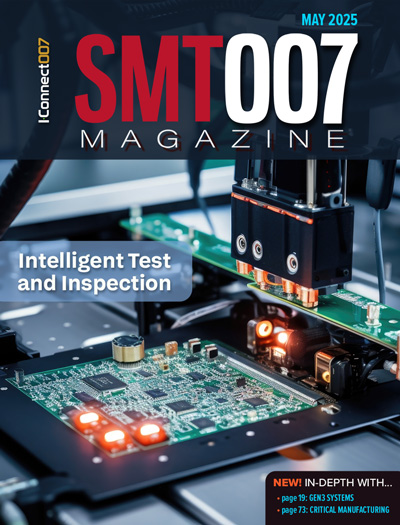-

- News
- Books
Featured Books
- smt007 Magazine
Latest Issues
Current Issue
What's Your Sweet Spot?
Are you in a niche that’s growing or shrinking? Is it time to reassess and refocus? We spotlight companies thriving by redefining or reinforcing their niche. What are their insights?

Moving Forward With Confidence
In this issue, we focus on sales and quoting, workforce training, new IPC leadership in the U.S. and Canada, the effects of tariffs, CFX standards, and much more—all designed to provide perspective as you move through the cloud bank of today's shifting economic market.

Intelligent Test and Inspection
Are you ready to explore the cutting-edge advancements shaping the electronics manufacturing industry? The May 2025 issue of SMT007 Magazine is packed with insights, innovations, and expert perspectives that you won’t want to miss.
- Articles
- Columns
- Links
- Media kit
||| MENU - smt007 Magazine
ZESTRON to Hold Free Webinar “Cleaning before Coating. A Cost Benefit Analysis”
September 21, 2015 | ZESTRONEstimated reading time: Less than a minute
ZESTRON, the worldwide leader in high precision cleaning products, services and training solutions for the electronics manufacturing industry, is pleased to announce the last installment in the 2015 5-Part Cleaning Webinar Series titled “Cleaning before Coating. A Cost Benefit Analysis”. This free-of-charge webinar is scheduled for October 9, at 3:00 pm (MYT).
Mr. GT Yeoh, Senior Application Engineer, will present the 45 minute webinar that concludes a 15 minute Q & A session.
What will you learn?
ZESTRON’s Cleaning Expert GT Yeoh will show you in this webinar, how cleaning before coating guards against field failures and how to get a positive cost benefit analysis. You will get an overview of the advantages of PCB coating under extreme climatic conditions like temperature fluctuations and dampness. Furthermore, you will be informed about methods to increase reliability and you will receive a cost-benefit analysis of a cleaning process.
Who should attend?
The webinars are designed for all interested parties and, in particular, production managers and operators, service and process engineers, quality assurance personnel and managers.
For more information or to register, please click here to visit our website or contact academy@zestronmalaysia.com.
Suggested Items
WellPCB, OurPCB Launch Low-Cost PCB Assembly and Custom Cable Assembly Solutions
05/29/2025 | ACCESSWIREWellPCB and OurPCB, world leading PCB manufacturing service providers, announced today that they have officially launched new Low-Cost PCB Assembly Solutions and Custom Cable Assembly services to meet the needs of the electronics manufacturing industry for high cost performance and flexible customization.
Electronics Industry Demand Holds Steady Amid Tariff Turbulence
05/22/2025 | IPCElectronics manufacturers are bracing for higher costs as profit pressures deepen according to IPC’s May Sentiment of the Global Electronics Manufacturing Supply Chain Report.
LitePoint, Pegatron 5G Successfully Launch Volume Manufacturing of 5G O-RAN Radio Units to Power Private 5G Networks
05/21/2025 | BUSINESS WIRELitePoint, a leading provider of wireless test solutions, and Pegatron 5G, a leading provider of end-to-end 5G product solutions, have jointly announced a milestone in their collaboration; the start of high-volume manufacturing for 5G O-RAN radio units.
Fresh PCB Concepts: The Power of a Lunch & Learn for PCB Professionals
05/15/2025 | Team NCAB -- Column: Fresh PCB ConceptsIn the electronics industry, innovation isn’t simply a competitive edge, it’s a survival strategy. For those working in printed circuit board (PCB) design, engineering, procurement, and quality control, staying informed and connected is key to creating high-performance, cost-effective, and manufacturable products. Enter the Lunch & Learn—a simple yet highly effective format for professional development offering technical insights in short, informal sessions (served with lunch).
Localized Automation Becomes a Tariff Storm Safe Haven, but U.S. Smart Factory Build-Out Costs Far Exceed China’s
05/09/2025 | TrendForceTrendForce’s latest “Human-Machine Technology Report” points out that although the 90-day delay on the U.S. reciprocal tariffs announced by the Trump administration in early April 2025 offers temporary relief, it has already triggered lasting shifts in global manufacturing and supply chain strategies.


